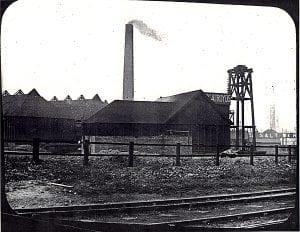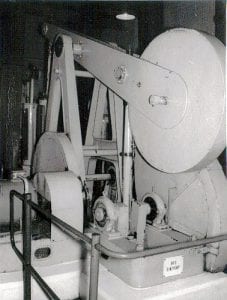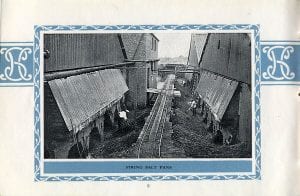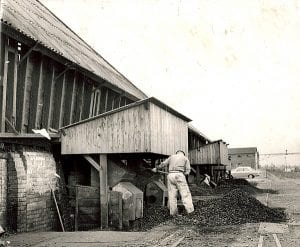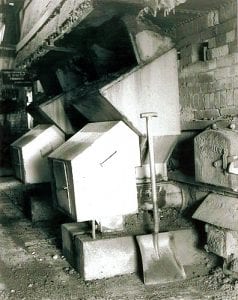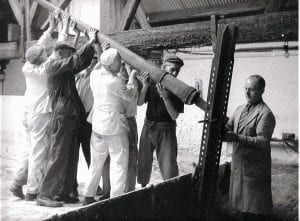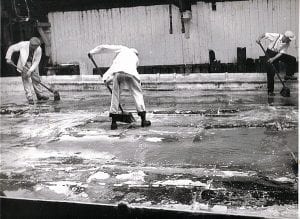SALT, RIVER AND CANAL
INTRODUCTION TO SALT
Brine is the source for salt, a form of saline water found naturally in the geological deposits underlying Middlewich. At certain locations the brine breaks out at the surface and can be collected for salt-making, and this was how the earliest brine was found.
During the medieval period, brine pits were dug and the brine was pulled out by bucket and sent along pipes or wooden conduits to the salt-houses or “Wych-houses”. The brine was stored in “ships”, long wooden troughs, or in barrels at the salt-houses, and was boiled in lead vats (or “leads”) over open hearths. The people who undertook the boiling processes were known as “wallers” and often the salt-making area was referred to as the “walling-lands”.
LAST WORKING OF THE COMMON PAN AT MURGATROYD'S
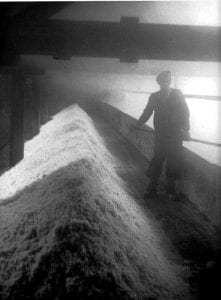 Technological innovation in post medieval times included the move from “leads” to iron “pans”, and after the canal was constructed, the use of narrow boats to ship the salt, rather than pack-horse or wagon, as used previously.
Technological innovation in post medieval times included the move from “leads” to iron “pans”, and after the canal was constructed, the use of narrow boats to ship the salt, rather than pack-horse or wagon, as used previously.
By the late 19th century deep shafts were sunk to find new sources of brine and pumps were used to lift the brine into the saltworks.
The growth of chemical industries created a whole range of new uses for salt and during the 19th and 20th centuries Middlewich became a centre of alkali and caustic soda production, as well as many other salt-related activities.
Salt works changed ownership over the decades, sometimes operating with more than one producer at the same works; at other times closing down for a period before reopening. It is therefore a complicated process to locate specific salt-works and ownership at certain times and when a variety of sources are consulted, sometimes contradictory information is provided. The names and locations contained in the project research are therefore the best interpretation possible from the sources.
THE OPEN PAN PROCESS
Illustrated by photographs from Seddon’s and Murgatroyds Salt Works, Middlewich.
Based on the project photo archive, project research and the Murgatroyds Open-Pan Salt Works, printed by Cheshire County Museums
The brine was then piped below ground and into the pans when required.
HEATING THE PANS
Low grade coal called ‘slack,’ was used to fire the pans, the heat passed through the brick flue system that runs under the pan. The flues enable a pan to be heated evenly; the excess heat goes through the hot-house area before it reaches the chimney.
FORMING OF SALT CRYSTALS
The salt crystals form or ‘set’ on the surface of the brine before sinking to the bottom of the pan. The fiercer the burn, the finer the grade of salt crystals, there were fine salt pans and common pans, the latter produced coarser salt for other industries to use. Seddon’s also produced large salt crystals known as ‘Lagos’ Salt, it was used as money in a province of Africa.
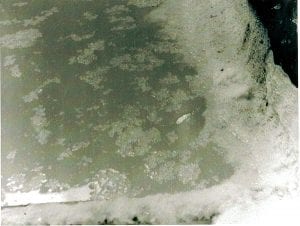
The ‘lumpmen’ would draw the pan with a ‘long handled rake’ (up to 3.5 metres), bringing the salt towards him. Using a skimmer the salt was then scooped and placed in ‘elm tubs’ on the rail known as ‘dogs’. The cooling process begins and the excess brine drains back into the pan.
The salt was packed down with a wooden tool called a ‘mundling stick’; this ensures the lump is compacted to produce the correct weight. When the salt lump was drained, they were placed on the hurdles, (wooden floor), either side of the pan until two rows had been formed.
LUMP SALT
Some blocks were sold as lump salt so they were finished off with a happer, a flat wooden tool used to smooth off the lump. Otherwise it would be left rough and end up in the crusher.
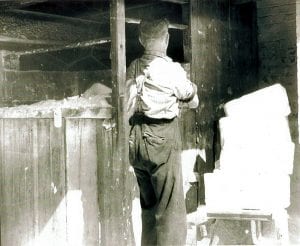
The lumps were turned out, loaded onto lump barrows and taken to the hot house where they stand on end in the ditches between the flues.
After four days they are laid flat on top of the flues for final storing. Lofters would use spikes to lift the lumps into the dry salt area, above the hot house where they waited to be crushed or cut into blocks.
17. After four days the salt lumps are dry enough to be moved. Seddon’s.jpg After four days the salt lumps are dry enough to be moved. Seddon’s. George Twigg ©
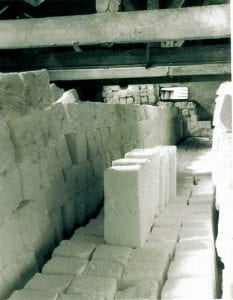
18. A Lofter moves the salt to the Dry Store, if they moved the lump any earlier the moisture would have weakened it and broken up as soon as the spike was used. Seddon’s.jpg
A Lofter moves the salt to the Dry Store, if they moved the lump any earlier the moisture would have weakened it and broken up as soon as the spike was used. Seddon’s. George Twigg ©
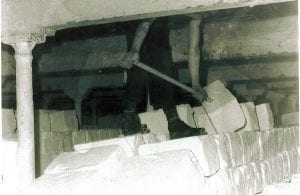
19. Seddons, lofting salt from drying into storage above.jpg
Seddons, lofting salt from drying into storage above. George Twigg ©
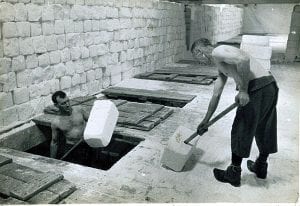
20. In the hothouse philip plumb 1960, Murgatroyd’s.jpg
In the hothouse philip plumb 1960, Murgatroyd’s. George Twigg ©
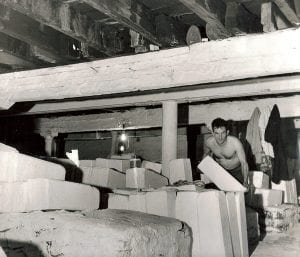
21. Feeding the lump crushing mill 1965-6. The salt is crushed up ready to be bagged up. Murgatroyd’s.jpg
Feeding the lump crushing mill 1965-6. The salt is crushed up ready to be bagged up. Murgatroyd’s. George Twigg ©
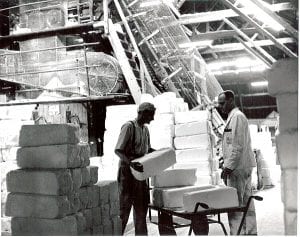
23. Close up of Seddon’s Crusher.jpg
Close up of Seddon’s Crusher
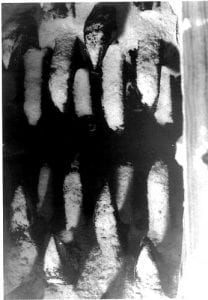
24. Bagging the salt coming through the chute from the crusher. The salt is now ready for it’s journey. Seddon’s.jpg
Bagging the salt coming through the chute from the crusher. The salt is now ready for it’s journey. Seddon’s.
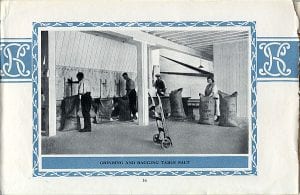
25. One of the Salt Storehouses. Sometimes salt was stored in crushed form, once an order came through the salt was then bagged. Seddon’s.jpg
One of the Salt Storehouses. Sometimes salt was stored in crushed form, once an order came through the salt was then bagged. Seddon’s
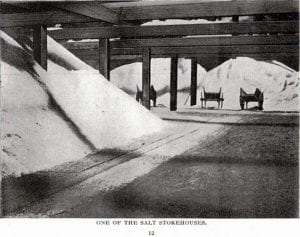
26. The Salt heaps had to be dug out, the salt, if left would form into a solid block again. Seddon’s.jpg
The Salt heaps had to be dug out, the salt, if left would form into a solid block again. Seddon’s.
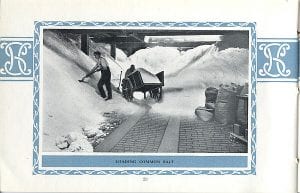
27. Packing Table Salt. Not all salt was bagged, dairy salt destined for households was packed in containers. Murgatroyd’s.JPG
Packing Table Salt. Not all salt was bagged, dairy salt destined for households was packed in containers. Murgatroyd’s. Philip Shales ©

Maintenance
The working week was Monday to Saturday morning, the men worked 12 hour shifts in very hot conditions. Every Monday the pans had to be de-scaled as the build up of salt would retain heat and damage the iron plates. A jigger lifted the pan so that the pan and flues could be checked and repaired if necessary.
At the weekend the fires were allowed to die out, the resulting salt crystals were called ‘weekend salt’.

